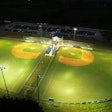It starts with a dotted line. Not the kind that stretches a short distance across the bottom of a contract, but one drawn to represent a closed circuit covering 400 meters.
 Photo of the track at Harvard University
Photo of the track at Harvard UniversityIt starts with a dotted line. Not the kind that stretches a short distance across the bottom of a contract, but one drawn to represent a closed circuit covering 400 meters. This is the path of travel of the lane-one runner, and it is the first step toward the painstaking process of building a competitive track.
There are contracts involved, to be sure. Few sports facility construction projects pull together as much expertise as that required of track building, whether it's a high school track or one worthy of a world record recognized by the International Association of Athletics Federations. "One of the unique things that we face with track and field construction that makes it a little challenging is adherence to all of the different governing bodies, and then building it to those exacting standards," says Kristoff Eldridge, track division president for the American Sports Builders Association and an ASBA Certified Track Builder. "While it might only be a high school track, it's still probably quite a bit more exacting than typical sports construction."
The level of competition determines, for example, if an aluminum rail separates a track's innermost lane from its infield. Olympic and NCAA records can only be set on a track featuring this two-inch-tall curbing, which sits directly on top of the inner lane line. "It forces the runner to stay in his lane so he can't cut the corners, so to speak," says ASBA immediate past chair Sam Fisher, of Fisher Tracks in Boone, Iowa. "When you put a rail on the track, that changes all the math."
If a track is to allow for such a curb (it can be removed when not in use), the track's inner lane line must be specified at 30 centimeters inside the aforementioned runner's 400-meter path. If no curb is needed, as is the case at the high school level, the track can be built with an inner line 20 centimeters removed from the runner's circuit. Says Fisher, "Somebody decided however many years ago that if you're running against a white stripe, you can run 20 centimeters from that stripe and not step on the stripe. You can safely compete at that distance. And if you step on the stripe, you may get disqualified, but you're not going to get hurt. At the high-end levels, you run against a rail, and because of the psychological fear of hitting that rail and breaking an ankle, you're afraid to run that close to it. It's determined that the path of travel is 30 centimeters from a rail. So there are tracks built for a rail. There are tracks built to not have a rail. One track cannot be built for both."
Where the second lane line is marked likewise varies. Olympic lanes must be a minimum of 1.22 meters (and no greater than 1.25 meters) wide. Lane widths on collegiate and high school tracks are typically 42 inches, or roughly six inches narrower than those on an IAAF track, and high school track lanes can be as narrow as 36 inches, though such a specification is not recommended. (All widths include the 5-centimeter lane line to the right of the runner, which is considered part of his or her lane.)
One reason for the difference, according to Eldridge, is real estate. While there is more land - and exponentially more tracks - in the United States than in Europe (where the IAAF makes its Monaco headquarters), space may be limited within the boundaries of an American high school campus, and narrower lanes make for a significantly smaller track footprint. "You're saving four feet in width - half a foot each lane - on an eight-lane track," Eldridge says, adding that the 42-inch lane is also an economic consideration. "That's four feet of base, four feet of pavement and four feet of surfacing."
 The road to perfect planarity and pitch begins with the laser-grading of sub-base material. (Photos courtesy of Cape and Island Tennis & Track)
The road to perfect planarity and pitch begins with the laser-grading of sub-base material. (Photos courtesy of Cape and Island Tennis & Track)Once the track has been designed to take into consideration curbs and lane widths, all of the various steps of track construction to which Eldridge alludes can begin. Here's where the rubber truly meets the road in terms of exacting specifications. But this is no parking-lot paving project. A competitive track, constructed with a sub-base of stone topped with two lifts of asphalt and covered by separate synthetic force-reduction and wear layers, must be sloped enough in cross-section to shed water, but flat enough in the runner's direction of travel that there is no "downhill" competitive advantage for one runner over those in other lanes or those posting recorded times on entirely different tracks. "It's so that every runner has the perfect opportunity to compete and no runner out in lane eight gets to run downhill when merging into lane one," Fisher says. "And it's much fairer to the athlete to be able to expect some minimum level of consistency from track meet to track meet, location to location."
Just how much of a drop is considered downhill? The maximum allowable cross-slope is 1 percent at the collegiate level and higher, and many high schools adhere to that standard despite National Federation of State High School Associations rules allowing for a cross-slope of up to 2 percent. At any level, the maximum allowable slope in the runner's direction of travel shrinks to one-tenth of 1 percent. Moreover, the surface cannot deviate more than a quarter of an inch over 10 feet in any direction.
"It has to be like a pitched pool table - perfectly flat, but with a pitch to it," Eldridge says. "A parking lot might have some waves in the pavement, but it's not an inconvenience. It doesn't have any impact on the long-term longevity of the surface. But if a track has waves in it, if something has settled or the track was paved with a little dip, it's very noticeable and unacceptable."
When built right, a person standing on the track should not perceive any sloping at all. "Most competitors, if you were to ask them, would tell you they are running on a dead-flat track," says Fisher, adding that a track's cross-slope at the highest levels of competition may be as negligible as one-half of 1 percent. "That slope is all the way around and has to be uniform all the way around. In other words, the straightaways can't be dead level and then the turns banked like a race car track. That slope serves one purpose only and that is to shed water."
"The challenge for a track builder is that designing a track oval with a cross-slope of less than 1 percent means that your pavement has to be perfect, because that's really flat," Eldridge says. "Any typical contract paver will tell you that it's too flat. They'll say, 'You can't pave it at less than 1 percent or else you'll get puddles.' Well, you can't have puddles, and it can't be more than 1 percent. That's the rule. So you just have to be more exacting. You have to build it better."
 A wear layer of rubber granules is applied to the track at Harvard University.
A wear layer of rubber granules is applied to the track at Harvard University.Standing water not only hastens the demise of a track over time, it can dent its usability on any given day. That's why great care is taken in building one from the bottom up. Depending on the stability of existing soils on the job site, the depth of sub-base stone required could range from four inches (over a free-draining compacted soil) to four feet or more (over clay, peat or loam). Regardless, setting the proper tolerances begins at this stage. "On most tracks, the stone tolerance might be a half-inch in 10 feet, and the asphalt is a quarter-inch in 10 in the first lift and a quarter-inch in 10 in the second lift," Fisher says. "If we're building a track that's going to have pre-Olympic competition on it, that stone base may be a quarter-inch in 10, and the asphalt will be an eighth of an inch in 10. Typically, when you get into the really high-end surfaces, more care has gone into the base and sub-base construction."
"The more accurate your sub-base material, the more accurate your paving is going to be," Eldridge adds. "Not only are you building a road, you're building a road at incredibly exacting tolerances and one that cannot move. It has to remain that perfect plane, and that's not easy to do."
It's so difficult, in fact, that builders will often establish an even more exacting target, setting their laser graders accordingly during the laying of sub-base material, and thus allowing for some - albeit, slight - margin of error during the remaining construction stages. Says Eldridge, "Typically, a designer who specializes in sports and knows these things will set the running-direction grade at zero and the cross-slope at .9 percent or .85, so that if there's any deviation from that by the guy who's paving the asphalt or putting the surfacing in, it doesn't exceed that 1 percent."
Asphalt layer thickness will vary by region of the country, and what type of stone is available to mix with the remaining two ingredients (sand and resin). In the Northeast, where Eldridge builds tracks for Cape and Island Tennis & Track in Pocasset, Mass., two inches of a binder mix goes down first and can be used to correct any deviations in the sub-base. An inch and a half of a denser mix employing smaller stone and more sand is paved on top of that. Using self-propelled paving equipment and an 11-foot-wide screed, one pass around the oval will pave three lanes, requiring one or more side-by-side passes (depending on the total number of lanes) and dictating that as many as 10 crew members are onsite to attend to edges, seams and surface deviations in an expeditious manner before the asphalt material cools. That said, the application of each lift is a daylong process. "It's all about temperature and making sure that you're able to allocate resources where they need to be allocated during the process if something is not perfect," Eldridge says, "because one of the things about paving is you never want to stop the operation."
The finished asphalt's planarity is determined using topographical survey equipment, and its water-shedding capability is observed either during a rain event or by flooding the surface with a fire hose. Minor deviations can be corrected with polyurethane or latex filler, whichever is compatible with the running surface that will be applied on top of it. Major pavement problems will require infrared reheating of the asphalt by the paving contractor - a solution that sometimes leads to further problems. "It's very difficult to fix pavement," Eldridge says. "It's crucial that each step of the process is done well, so that you avoid that sort of thing."
Any deviation in the pavement will lead to a running surface - applied as separate force-reduction and wear layers - that's not a uniform depth all the way around, but rather too thick or too thin in a particular problem spot. Even the perfectly paved and surfaced track will be subjected to wear-induced deviations over time - from grass and sand encroachment to foot traffic resulting from public recreational use (seniors walking, for example), cheerleaders, runners wearing overly aggressive spikes and football, soccer and lacrosse players crossing the track in cleats. Surface degradation can be mitigated by varying on a daily basis those lanes open to the public and by protecting the synthetic wear layer with a manufacturer-recommended cover in high-traffic areas during other sporting events.
One can make the case that the emergence of field sports such as soccer and lacrosse in America has resulted in better tracks being built here. "An old-fashioned, U.S.-built running track was equal quadrants - the straightaways were 100 meters and the turns were 100 meters - a relatively long and narrow footprint, and the reason was American football," Eldridge says. "Most fields now aren't just for football, though. They're multipurpose, especially where synthetic turf is used. As a result, the tracks have adopted a wider, actually more European style. The turns are longer and more gradual. And because the turns are not as aggressive, the track is going to be a little faster."
The runner's path, that original dotted line in the building process, still has to cover exactly 400 meters - "There is no tolerance for short," Fisher says - and the runner in lane one has to be, for all intents and purposes, at the same elevation as the runner in lane eight.
Widespread adherence to these design principles within the past 20 years has no doubt provided the biggest boost to the quality of U.S. track construction at all levels. The NCAA track and field rulebook, for example, defers to the ASBA Construction and Maintenance Manual for technical information on construction, layout and marking, and ASBA now offers certification for both track builders and finished tracks. "IAAF had offered the only track certification, but to get it, one had to build an Olympic-caliber track. ASBA has introduced different levels of certification for the various levels of competition," Eldridge says. "Say a kid breaks the 100-meter record at his high school state championship meet. They can just show the NFHS the certification that says the lines are accurate and that the distance is as it should be. At the collegiate level, the records process is a little bit more stringent and will typically involve a topographic survey that says that the track isn't downhill, for example, and that it adheres to all the slope tolerances. There's certification for that, as well."
"We're not a rule-making body by any means," Fisher says of ASBA, "but our recommendations have been taken to heart and are followed as standard construction practice now, so that we have some real consistency in track construction. And with the certified builder program, which started taking hold in the mid-'90s, we've seen a dramatic increase in the consistency of quality-built tracks. And I'm not talking Olympic tracks; I'm just talking quality-built high school tracks that you can hold a state track meet on and be assured that any record set will stand."





































